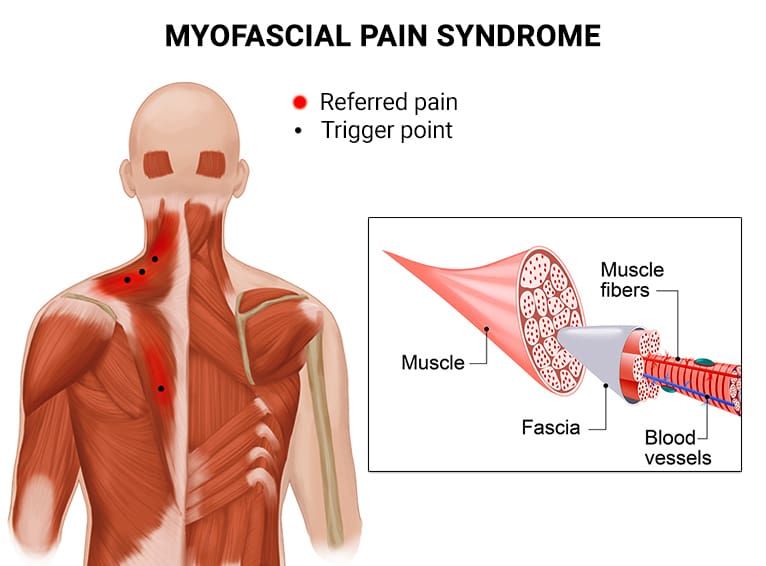Can individuals dealing with myofascial pain syndrome in their bodies find the relief they are looking for through acupuncture?
Contents
Introduction
The musculoskeletal system has numerous ligaments, joints, soft tissues, and muscles that allow the body to be in motion without feeling pain or discomfort. The musculoskeletal system has upper and lower body portions, and each quadrant has a specific job it needs to do. The head works with the neck for the upper body portions to allow it to turn and be mobile. The shoulders work with the arms and hands to allow flexibility while stabilizing the neck. For the lower body portions, the hips and legs stabilize the upper body’s weight and help the different quadrants flex, extend, and rotate without pain. However, when traumatic or normal forces start to affect the body, it can lead to pain and discomfort, depending on the severity. When this happens, it can cause the muscle fibers from the upper and lower body portions to become tight and form tiny nodules known as trigger points to cause myofascial pain. This causes many individuals to be in constant discomfort and feel pain in different body locations. However, there are numerous treatments that can reduce the pain from the trigger points and restore muscle function to the body. Today’s article examines how myofascial pain syndrome affects the body, how non-surgical treatments like acupuncture can reduce trigger point pain, and how acupuncture can restore body function. We speak with certified medical providers who incorporate our patients’ information to provide various treatments to reduce the effects of myofascial pain syndrome on the body. We also inform patients how non-surgical therapies like acupuncture can help restore body function that is caused by myofascial pain. We encourage our patients to ask intricated questions to our associated medical providers about the pain-like symptoms they are experiencing from myofascial pain syndrome that is affecting their bodies. Dr. Alex Jimenez, D.C., utilizes this information as an academic service. Disclaimer.
Myofascial Pain Syndrome Affecting The Body
Do you feel pain radiating in certain locations in your body, affecting your daily routine? Are you feeling any complaints in your back, knees, elbows, or shoulders? Or do you have mobility issues that are affecting your gait and making you feel unstable? Many of these issues that people are experiencing are known as myofascial pain syndrome, and it can cause overlapping risk profiles in the musculoskeletal system. Myofascial pain syndrome is a problematic musculoskeletal pain originating from the muscles and surrounding fascia. (Tantanatip & Chang, 2023) This common musculoskeletal condition causes localized pain in certain body areas or referred pain to various muscle locations. When a person is dealing with myofascial pain syndrome, their muscles in the upper or lower body quadrants will become overstretched and tight through repetitive motions that can cause tiny nodules known as trigger points that can be a source of where the pain might originate from. When people are dealing with myofascial pain syndrome in their bodies, they will inform their primary doctors that they are experiencing pain in different locations in their bodies that are causing them pain. The doctor then will ask the individual numerous questions and examine where the pain is occurring. The doctor will also take note of the person’s daily routine, allowing the doctor to diagnose that myofascial pain syndrome is at play.

When myofascial pain syndrome affects body function, it can come in the forms of nociceptive pain and neuropathic pain. When the muscle fibers in the upper and lower extremities are dealing with trigger points, the surrounding nerve roots that provide the sensory-motor function to the arms and legs can become irritated, causing spot tenderness, referred pain, and nerve root compression that can cause the muscles to succumb to muscle trauma and muscle overload. (Fernandez-de-Las-Penas et al., 2023) To that point, myofascial pain syndrome can affect a person’s quality of life as the mechanisms of the comorbidities combined with the psychological stressors that are impacting the muscles might sensitize the trigger points. (Sabeh et al., 2020) However, when the pain becomes excruciating in the muscles that are caused by myofascial pain syndrome, many individuals will start to seek treatment to not only reduce the pain but also restore their body functionality.
The Non-Surgical Approach To Wellness- Video
Have you been dealing with radiating or localized pain in different body locations? How about experiencing mobility issues when moving your upper or lower extremities? Or do you experience stability issues from walking from one location to another? Many of these pain-like scenarios are associated with myofascial pain syndrome that is affecting the musculoskeletal system. When the human body is dealing with myofascial pain syndrome, it can be difficult to diagnose due to the affected muscles causing referred pain. At the same time, when a person is dealing with myofascial pain syndrome is not finding treatment to reduce the pain, it can lead to major health problems like:
- Mobility impairment
- Muscle pain and hypersensitivity
- Nerve issues
- Neurological issues
When people with myofascial pain syndrome are looking for treatment, they are looking for cost-effective treatments that can be combined with other therapies that can help reduce the pain and restore body function to the extremities. Non-surgical treatments can be the solution for many individuals because they are cost-effective and can be personalized. The video above shows how non-surgical treatments like chiropractic care can help restore the body through manual and mechanical manipulation that can stretch and locate the trigger points while restoring body function to the extremities.
Acupuncture Reducing Trigger Point Pain

When a person goes in for non-surgical treatments for their myofascial pain syndrome, acupuncture could be the answer. Acupuncture is an Eastern medical practice from China performed by highly trained licensed professionals. So, how can acupuncture help alleviate trigger point pain from myofascial pain syndrome? Acupuncturists use solid, super thin needles to place them in specific points in the body to reduce the referred pain-like symptoms causing issues. This causes the myofascial trigger points to become inactive and, reduces intramuscular hypertension, relieves uneven musculoskeletal pull, and improves mechanical balance in the upper and lower extremities. (Lin et al., 2022)
Acupuncture Restoring Body Function
Acupuncture is traditionally used to restore the normal flow of energy to the body. Still, in the modern era, it has been shown to have multiple positive effects on the central and peripheral nervous systems. So, since myofascial pain syndrome is both nociceptive and neuropathic, the effects of acupuncture can change the pain’s perspective while causing the body’s natural healing process to be restored. (Kelly & Willis, 2019) At the same time, acupuncturists can gently prick and stimulate the affected tendon with the myofascial to induce a muscle twitch to relax the tight muscle. (Qiu et al., 2023) This allows the body to relax and helps reduce the chances of trigger points returning to the muscle facia. For individuals who are looking for treatment for their myofascial pain syndrome, incorporating acupuncture could be the solution to restore body function to the musculoskeletal system.
References
Fernandez-de-Las-Penas, C., Nijs, J., Cagnie, B., Gerwin, R. D., Plaza-Manzano, G., Valera-Calero, J. A., & Arendt-Nielsen, L. (2023). Myofascial Pain Syndrome: A Nociceptive Condition Comorbid with Neuropathic or Nociplastic Pain. Life (Basel), 13(3). https://doi.org/10.3390/life13030694
Kelly, R. B., & Willis, J. (2019). Acupuncture for Pain. American Family Physician, 100(2), 89-96. https://www.ncbi.nlm.nih.gov/pubmed/31305037
https://www.aafp.org/pubs/afp/issues/2019/0715/p89.pdf
Lin, X., Li, F., Lu, H., Zhu, M., & Peng, T. Z. (2022). Acupuncturing of myofascial pain trigger points for the treatment of knee osteoarthritis: A systematic review and meta-analysis. Medicine (Baltimore), 101(8), e28838. https://doi.org/10.1097/MD.0000000000028838
Qiu, X. H., Yang, X. Y., Wang, Y. Y., Tian, S. L., Yan, Y. B., Xu, A. P., Fu, F., Wen, F. Y., Yang, Y., Zhang, Y., Zhang, Y. Q., Yang, Z. W., Xu, C., Sun, Q. H., Wu, X. L., Dai, X. Y., Li, N., & Cheng, K. (2023). Myofascial acupuncture versus routine acupuncture for mechanical neck pain: a protocol for a multicentre randomised controlled trial. BMJ Open, 13(8), e068129. https://doi.org/10.1136/bmjopen-2022-068129
Sabeh, A. M., Bedaiwi, S. A., Felemban, O. M., & Mawardi, H. H. (2020). Myofascial Pain Syndrome and Its Relation to Trigger Points, Facial Form, Muscular Hypertrophy, Deflection, Joint Loading, Body Mass Index, Age and Educational Status. J Int Soc Prev Community Dent, 10(6), 786-793. https://doi.org/10.4103/jispcd.JISPCD_328_20
Tantanatip, A., & Chang, K. V. (2023). Myofascial Pain Syndrome. In StatPearls. https://www.ncbi.nlm.nih.gov/pubmed/29763057
Disclaimer
General Disclaimer, Licenses and Board Certifications *
Professional Scope of Practice *
The information herein on "Treating Acupuncture Myofascial Pain Syndrome Effectively" is not intended to replace a one-on-one relationship with a qualified health care professional or licensed physician and is not medical advice. We encourage you to make healthcare decisions based on your research and partnership with a qualified healthcare professional.
Blog Information & Scope Discussions
Welcome to El Paso's Premier Wellness and Injury Care Clinic & Wellness Blog, where Dr. Alex Jimenez, DC, FNP-C, a Multi-State board-certified Family Practice Nurse Practitioner (FNP-BC) and Chiropractor (DC), presents insights on how our multidisciplinary team is dedicated to holistic healing and personalized care. Our practice aligns with evidence-based treatment protocols inspired by integrative medicine principles, similar to those on this site and on our family practice-based chiromed.com site, focusing on naturally restoring health for patients of all ages.
Our areas of multidisciplinary practice include Wellness & Nutrition, Chronic Pain, Personal Injury, Auto Accident Care, Work Injuries, Back Injury, Low Back Pain, Neck Pain, Migraine Headaches, Sports Injuries, Severe Sciatica, Scoliosis, Complex Herniated Discs, Fibromyalgia, Chronic Pain, Complex Injuries, Stress Management, Functional Medicine Treatments, and in-scope care protocols.
Our information scope is multidisciplinary, focusing on musculoskeletal and physical medicine, wellness, contributing etiological viscerosomatic disturbances within clinical presentations, associated somato-visceral reflex clinical dynamics, subluxation complexes, sensitive health issues, and functional medicine articles, topics, and discussions.
We provide and present clinical collaboration with specialists from various disciplines. Each specialist is governed by their professional scope of practice and their jurisdiction of licensure. We use functional health & wellness protocols to treat and support care for musculoskeletal injuries or disorders.
Our videos, posts, topics, and insights address clinical matters and issues that are directly or indirectly related to our clinical scope of practice.
Our office has made a reasonable effort to provide supportive citations and has identified relevant research studies that support our posts. We provide copies of supporting research studies upon request to regulatory boards and the public.
We understand that we cover matters that require an additional explanation of how they may assist in a particular care plan or treatment protocol; therefore, to discuss the subject matter above further, please feel free to ask Dr. Alex Jimenez, DC, APRN, FNP-BC, or contact us at 915-850-0900.
We are here to help you and your family.
Blessings
Dr. Alex Jimenez DC, MSACP, APRN, FNP-BC*, CCST, IFMCP, CFMP, ATN
email: coach@elpasofunctionalmedicine.com
Multidisciplinary Licensing & Board Certifications:
Licensed as a Doctor of Chiropractic (DC) in Texas & New Mexico*
Texas DC License #: TX5807, Verified: TX5807
New Mexico DC License #: NM-DC2182, Verified: NM-DC2182
Multi-State Advanced Practice Registered Nurse (APRN*) in Texas & Multi-States
Multi-state Compact APRN License by Endorsement (42 States)
Texas APRN License #: 1191402, Verified: 1191402 *
Florida APRN License #: 11043890, Verified: APRN11043890 *
License Verification Link: Nursys License Verifier
* Prescriptive Authority Authorized
ANCC FNP-BC: Board Certified Nurse Practitioner*
Compact Status: Multi-State License: Authorized to Practice in 40 States*
Graduate with Honors: ICHS: MSN-FNP (Family Nurse Practitioner Program)
Degree Granted. Master's in Family Practice MSN Diploma (Cum Laude)
Dr. Alex Jimenez, DC, APRN, FNP-BC*, CFMP, IFMCP, ATN, CCST
My Digital Business Card
Licenses and Board Certifications:
DC: Doctor of Chiropractic
APRNP: Advanced Practice Registered Nurse
FNP-BC: Family Practice Specialization (Multi-State Board Certified)
RN: Registered Nurse (Multi-State Compact License)
CFMP: Certified Functional Medicine Provider
MSN-FNP: Master of Science in Family Practice Medicine
MSACP: Master of Science in Advanced Clinical Practice
IFMCP: Institute of Functional Medicine
CCST: Certified Chiropractic Spinal Trauma
ATN: Advanced Translational Neutrogenomics
Memberships & Associations:
TCA: Texas Chiropractic Association: Member ID: 104311
AANP: American Association of Nurse Practitioners: Member ID: 2198960
ANA: American Nurse Association: Member ID: 06458222 (District TX01)
TNA: Texas Nurse Association: Member ID: 06458222
NPI: 1205907805
| Primary Taxonomy | Selected Taxonomy | State | License Number |
|---|---|---|---|
| No | 111N00000X - Chiropractor | NM | DC2182 |
| Yes | 111N00000X - Chiropractor | TX | DC5807 |
| Yes | 363LF0000X - Nurse Practitioner - Family | TX | 1191402 |
| Yes | 363LF0000X - Nurse Practitioner - Family | FL | 11043890 |








